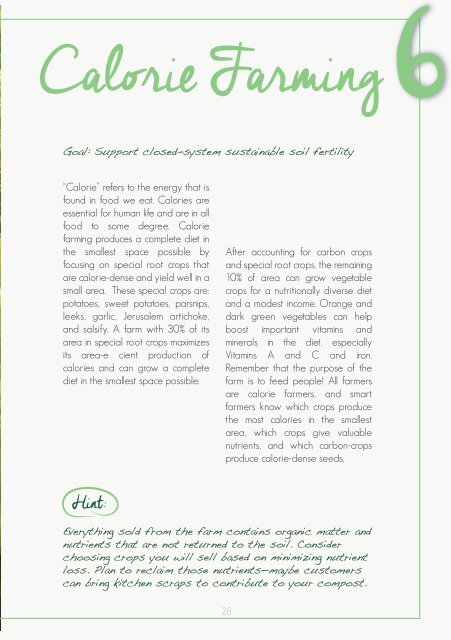Create successful ePaper yourself
Turn your PDF publications into a flip-book with our unique Google optimized e-Paper software.
Calorie Farming<br />
Goal: Support closed-system sustainable soil fertility<br />
“Calorie” refers to the energy that is<br />
found in food we eat. Calories are<br />
essential for human life and are in all<br />
food to some degree. Calorie<br />
farming produces a complete diet in<br />
the smallest space possible by<br />
focusing on special root crops that<br />
are calorie-dense and yield well in a<br />
small area. These special crops are:<br />
potatoes, sweet potatoes, parsnips,<br />
leeks, garlic, Jerusalem artichoke,<br />
and salsify. A farm with 30% of its<br />
area in special root crops maximizes<br />
its area-e cient production of<br />
calories and can grow a complete<br />
diet in the smallest space possible.<br />
After accounting for carbon crops<br />
and special root crops, the remaining<br />
10% of area can grow vegetable<br />
crops for a nutritionally diverse diet<br />
and a modest income. Orange and<br />
dark green vegetables can help<br />
boost important vitamins and<br />
minerals in the diet, especially<br />
Vitamins A and C and iron.<br />
Remember that the purpose of the<br />
farm is to feed people! All farmers<br />
are calorie farmers, and smart<br />
farmers know which crops produce<br />
the most calories in the smallest<br />
area, which crops give valuable<br />
nutrients, and which carbon-crops<br />
produce calorie-dense seeds.<br />
Hint:<br />
Everything sold from the farm contains organic matter and<br />
nutrients that are not returned to the soil. Consider<br />
choosing crops you will sell based on minimizing nutrient<br />
loss. Plan to reclaim those nutrients—maybe customers<br />
can bring kitchen scraps to contribute to your compost.<br />
28







